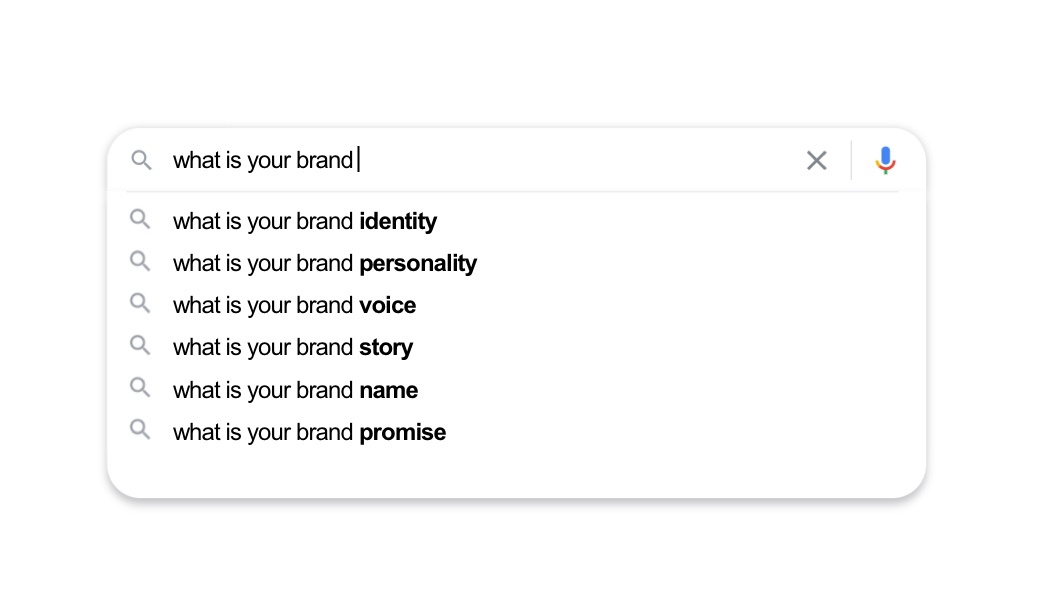
Luckily, finding questions that are top-of-mind is the easy part. Google is a great resource for this because their predictive search feature automatically shows you the most popular search topics.
The blessing and curse of the results of those Google searches though is that they provide access to a wide range of resources. That range is great if you want variety but challenging if you want a set of ideas that are cohesive.
In this piece we wanted to take some of these common questions, provide info and resources for them, and show how they fit together.
With more cohesive information you’ll be better equipped to create a cohesive brand. And the benefit of a cohesive brand is that you’ll create consistent interactions that build engagement, trust, and loyalty with your customers.
With that goal in mind, let’s dive into some of the top questions people search Google for about their brand.
NOTE: You can also visit our Field Guide for resources on each of these topics.
First, A BIG Question That’s Not On The List: Brand Positioning

Before we get into Google’s top questions, we need to address an important question that’s not on the list.
What Is Your Brand Positioning Strategy?
While all the questions in Google’s list are valuable, it’s hard to answer them without first understanding your positioning.
In our process, we define your positioning around 3 key elements:
- What your Customers need and what they value most in a solution
- Where your brand fits in the landscape and how it’s different relative to the Competition
- How your brand’s Offering delivers on the needs of your customers in a unique way
While we might refer to this as “Brand Positioning” as you can see what we’re really talking about is the positioning of your business as a whole. That’s a pretty important topic.
Most of the questions in Google’s list speak to how your brand expresses that position. So, the best thing you can do is to get clear on your positioning first before jumping into these other questions.
If there’s one big takeaway from this list, it’s that you should spend a majority of your time understanding the problem that you’re solving and your position around it before you try to communicate about it.
Question: What Is Your Brand Identity?
Answer:
You can think of your brand identity as the “public face” of your brand strategy. It lets the rest of the world — and especially your target customers — know what you’re about at a glance.
Your brand identity includes the components that we see and engage with on the surface:
- Brand Name
- Brand Colors
- Brand Typeface
- Brand Symbol / Logo
None of these elements alone can make or break your connections with customers but they do contribute to the initial emotional response people have with your brand.
How To Make It Cohesive With Your Brand:
The goal with all of these elements is to put aside your personal preferences and focus on what name, color, typefaces, visuals best speak to the needs of your customers.
Again, this is why starting with your positioning (see above) is a critical first step. It gives you the context about your customers and the competitive space to make informed decisions about your identity.
It keeps you in the mindset of “how will this help us connect with our customers” as opposed to “what do I think looks cool”.
We have more resources on the individual elements in our field guide, and we cover names in more detail below.
If you need to evaluate your brand logo specifically, we created a scoring rubric to help compare and contrast options. It won’t make the decision for you, but it can bring in a little objectivity to an otherwise difficult decision.
To use it, score each logo (including your current logo if you have one) on the criteria and total up the score to see which options are best:
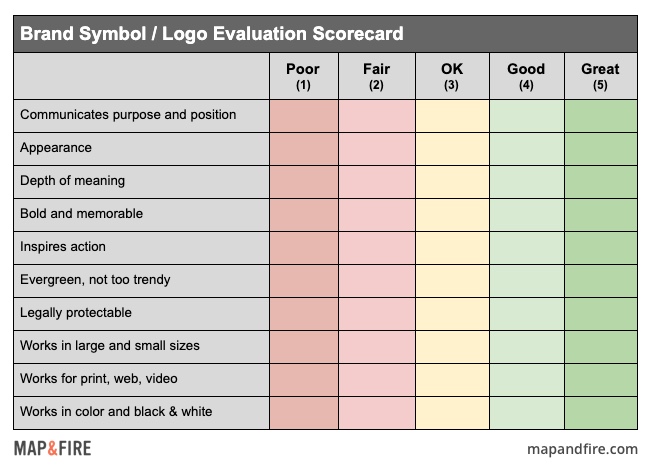
Question: What Is Your Brand Personality?
Answer:
There are lots of ways to define a brand’s personality or attributes — aka. the qualities and characteristics that make a brand distinct. The tool we find the most effective for this is to align a brand with one or more archetypes.
Archetypes help encompass your brand’s overall personality and works as a mental shortcut for you and your team when thinking about that collection of attributes.
Aligning your brand with an easily identifiable archetype helps your customers and your team quickly understand what you offer and how to interact with you.
This is particularly useful when developing messaging. It’s easier to think of how a character might speak to your customers as opposed to the words coming from an abstract concept like your business or brand.
How To Make It Cohesive With Your Brand:
It’s unlikely that your brand’s personality will align exclusively with one archetype. Instead we like to use a combination of two or three archetypes.
We have an entire resource section dedicated to this topic that you can use. The quick version is to select a primary, secondary, and tertiary archetype that together represent the unique set of characteristics of your brand.
And remember, like your identity, your brand archetype isn’t about your personal preferences. It’s about what character would best complement the needs of your target customer.
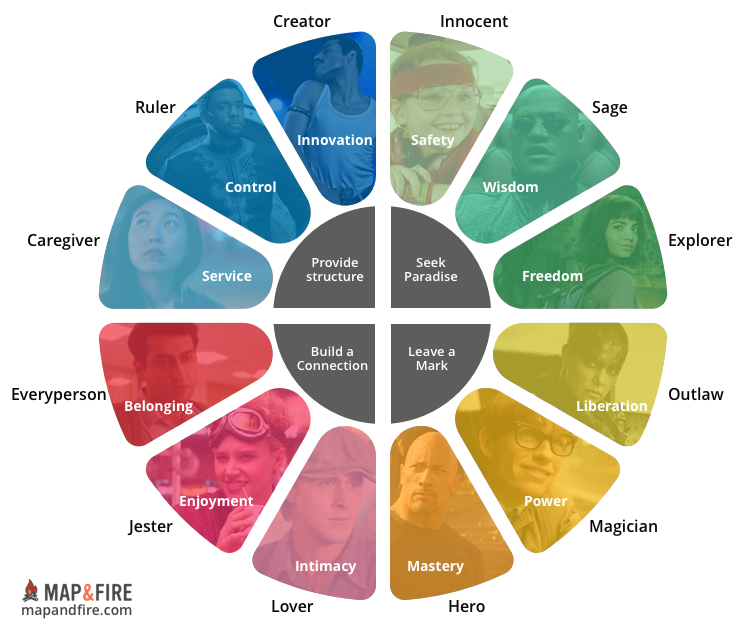
Question: What Is Your Brand Voice?
Answer:
Your brand voice is a close extension of your brand personality and archetypes. Your voice includes your tone as well as the language you use when you communicate with your customers.
Tone of voice describes the emotional quality of your communication. It’s linked to your archetype, but there’s plenty of room within that to make it unique.
Your tone of voice can have a lot of subtle and specific aspects to it. And that’s exactly why it’s important to define it clearly to retain that consistency for everyone on your team that uses it.
In addition to tone, the specific words and phrases your brand uses — and doesn’t use — further crystallize your voice.
How To Make It Cohesive With Your Brand:
You’ll see a recurring theme here, but the key question we ask when defining your voice is: “What tone and language would best create an emotional connection with your target customers?”
The best way to help answer this of course is actually talking to your customers. Listen to how they speak and the words they use. One of the most effective ways to connect with your audience is to reflect back a voice that’s natural and familiar to them.
With those ideas locked in your head, you can define your tone of voice with a couple exercises that we developed. These are both based on research conducted by the well-respected User Research consultancy the Nielsen Norman Group.
The first part of the Tone exercise involves choosing a position on four sets of opposite words.
For each of the four word pairings below, place an “X” in the box that best corresponds to the Tone you desire for your business.
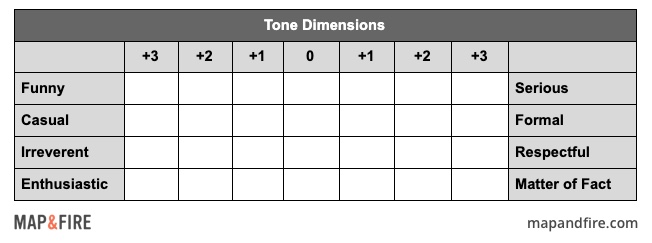
Highlight 4 – 6 words that describe your desired tone well.
Strikethrough up to 6 words that do not describe your desired tone.
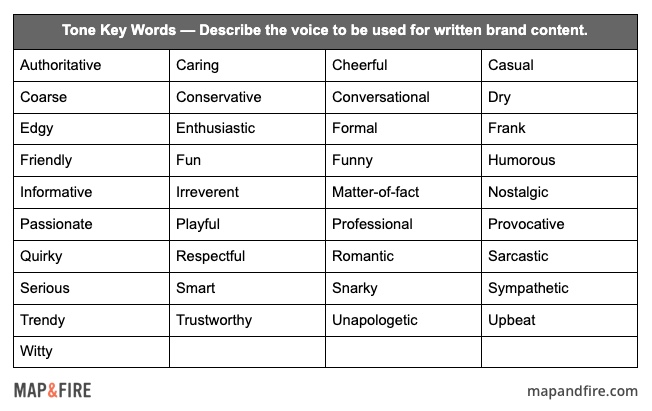
The next step is to compile lists of common words and phrases that define your brand’s voice. Remember to include both what you do say as well as what you don’t.
Question: What Is Your Brand Story?

Answer:
Your brand story is a tool that brings together the origin, position, and purpose of your brand into a short, simple narrative.
It’s a way to translate those strategic elements into content that’s emotionally engaging and expresses the brand’s personality. Your story communicates the importance of your brand in a way that both your team and your customers will easily understand and remember.
That ability of people to remember the essence of your brand is critical. Part of your work in defining your brand is to provide tools so people can remember you and so they can tell others about you, too.
This is why your brand story is a valuable tool for everything from onboarding to word-of-mouth referrals. You’re giving people a script for how to talk about your brand effectively.
How To Make It Cohesive With Your Brand:
Here are some guidelines to help you construct an effective brand story.
Your brand story should be:
- Short — aim for 3-4 paragraphs that are each 3-4 sentences max
- Clear — make it obvious what unique value the brand provides to customers
- Personal — explain why this business exists and the passion that fuels it
- Digestible — use language that’s easy to read and remember, without jargon
- Engaging — try and strike an emotional chord with the reader
And then the actual content of the story should include:
- Why your brand exists in the big picture sense, your brand’s thesis
- Who the founders are and how the company started
- What makes your positioning unique, what unmet need it fulfills
- How your brand will make an impact and change the competitive landscape
Question: What Is Your Brand Name?
Answer:
Your name is typically the first point of contact your audience has with your brand. It’s your first opportunity to express something meaningful and memorable about your brand and the value it provides.
Creating a meaningful brand name can be a challenging and stressful exercise. Beyond any best practices criteria that help define a good name, there’s always a high level of personal preference that’s impossible to escape.
The good news is that even the most famous brand names in the world can be teased apart to show varying degrees of strengths and weaknesses. There’s no perfect name. There will always be some people who like your name and some people who don’t.
In the end, it’s the value your brand provides that determines your success, not your name. But you should still try and maximize the impact that your name can make.
How To Make It Cohesive With Your Brand:
When exploring names, it’s important to consider all the factors that go into it.
If you’re in the process of developing a name for a new company or for a full rebrand, the rubric below includes 10 criteria to consider to evaluate the strength of any names you’re considering.
Like the brand logo exercise, the goal is to provide some structure for more objective, productive conversations with your business partners, team, family, etc.
To use it, score each name (including your current name if you have one) on the criteria and total up the score to see which options are best:
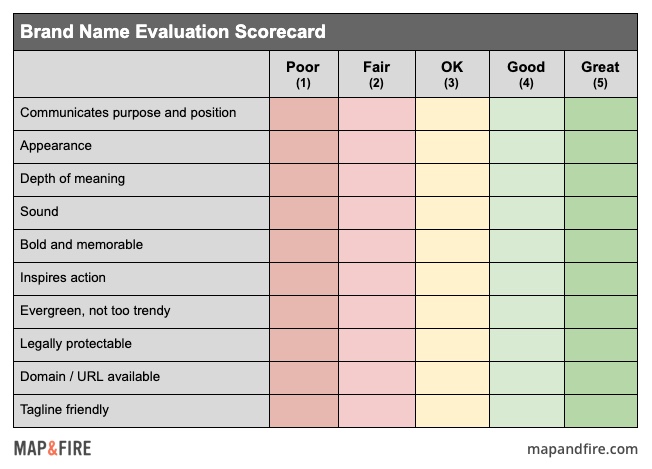
Question: What Is Your Brand Promise?

Answer:
A brand promise lives at the intersection of your purpose and your positioning.
From the purpose side, your promise connects to your larger “why” — the reason your brand exists in the first place. It’s the essence of what your brand strives to achieve in the world. It’s an idea that lives beyond financial goals and doesn’t include any methods, means, or specific approaches or executions.
From the positioning side, your promise connects to the unique value that you deliver to your customers. It speaks to the fundamental job that your customers need to satisfy and how you deliver on those needs.
A brand promise brings these ideas together in a short, simple, idea that your brand strives to deliver on with every single one of your customers, every time.
How To Make It Cohesive With Your Brand:
Developing a brand promise is simple in concept but often tricky in practice.
To do it well, the first steps would be to define your brand purpose and positioning. With a strong sense of those two elements, developing a brand promise becomes much more clear.
Once you have those ingredients, here are some attributes to help you define an effective brand promise:
- Short — your promise should be a concise, memorable, singular idea
- Actionable — your promise should speak to the value your brand delivers
- Specific — your promise should highlight what makes that value unique
- Consistent — your promise needs to be delivered to every customer, every time
- Authentic — your promise needs to be grounded and believable
The Secret To A Cohesive Brand – Understand The Pieces
It’s easy to see how people can get lost and overwhelmed when developing their brand. It’s also easy to see how that confusion can lead to a brand that’s inconsistent and ineffective.
Like any complex problem though, the secret is to start by breaking it down into bite-sized pieces. Get clear about the building blocks before you try and construct a giant tower.
As we note throughout this article, while it’s fun to think about things like your brand’s name, voice, and personality, those things will only be impactful if you first understand your positioning.
Learn what your customers value. See where you can differentiate yourself in the market, Define the unique value you can deliver.
With those blocks in place, you’ll have a much clearer view of how everything fits together and it’ll be much easier to express your brand consistently and cohesively.

Get Help Creating A Cohesive Brand
If you’re ready to build stronger connections with your customers, reach out for a free consultation. We’ll help you transform your best business thinking into an actionable, shareable, growth-oriented guide. Click below to learn more about the Brand Guidebook process.

